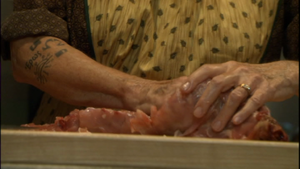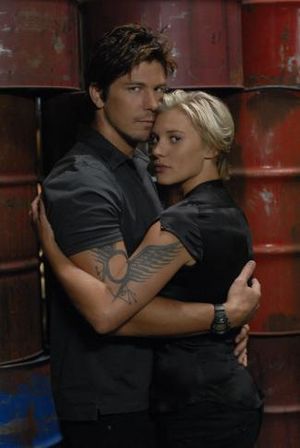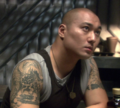Tattoo
More actions
This article on Tattoo is a shard, or a part, of a larger article (Arts and Literature of the Twelve Colonies). Please direct all edits there.
|

Many Taurons sport tattoos, from which can be read essential aspects of their life stories, including familial connections. The most extensive tattoos are found among members of the Ha'la'tha crime syndicate, and many Capricans associate the practice with the Ha'la'tha (CAP: "Gravedancing"). However, members of the Heracleides militia were also illustrated (CAP: "The Dirteaters").

Instead of wearing wedding rings, Samuel Anders and Kara Thrace[continuity 1] created tattoos on their arms that, when they embrace, form a unified circle with wings. The symbol for the colony of Caprica is also in view[production 1].
From a behind-the-scenes perspective, Michael Trucco adds that it is their wedding band, but that this is never fully explained in the show. Further, these matching tattoos are applied by the makeup department.
Other
editFelix Gaeta displays a tattoo of a rather large tiger during his interview with D'Anna Biers (TRS: "Final Cut"). Gaeta indicated he was quite inebriated with ambrosia to minimize the pain of the tattoo.
Socinus has a tattoo of an Aries design on his right arm (TRS: "Kobol's Last Gleaming, Part I").[continuity 2]
An unnamed pilot has many tattoos on both upper arms, depicting a tiger and a dragon, among other things.
Vireem, specialist aboard the battlestar Pegasus, has a complex tattoo on his left bicep, featuring a Chinese-style dragon and glyph (TRS: "Pegasus" and "Resurrection Ship, Part II")[continuity 3].
Cite error: <ref> tags exist for a group named "continuity", but no corresponding <references group="continuity"/> tag was found
Cite error: <ref> tags exist for a group named "production", but no corresponding <references group="production"/> tag was found




